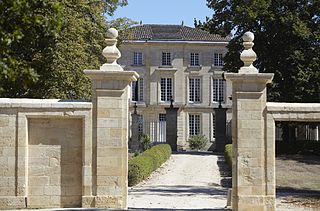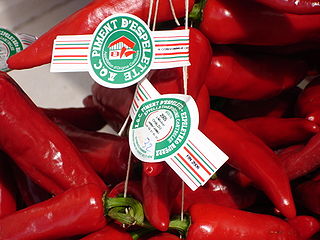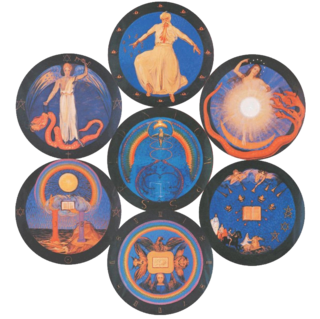Château Cheval Blanc, is a wine producer in Saint-Émilion in the Bordeaux wine region of France. As of 2012, its wine is one of only four to receive the highest rank of Premier Grand Cru Classé (A) status in the Classification of Saint-Émilion wine, along with Château Angélus, Château Ausone, and Château Pavie.

In 1955 the wines of Saint-Émilion in the wine-growing region of Bordeaux were classified. Unlike the Bordeaux Wine Official Classification of 1855 covering wines from the Médoc and Graves regions, the Saint-Émilion list is updated every 10 years or so. Following the initial classification, the list was updated in 1969, 1986, 1996 and most recently in 2006. However the 2006 classification was declared invalid following a series of legal actions, and the 1996 version of the classification has been reinstated for the vintages from 2006 to 2009.

Château Figeac is a wine estate in the Saint-Émilion appellation of Bordeaux. It is the largest estate in Saint-Émilion, with 40 hectares of vineyards. Due to its soil, which is dominated by gravel, it is planted in grape varieties Cabernet Sauvignon (35%), Cabernet Franc (35%), and Merlot (30%). Most other Saint-Émilion wines are dominated by Merlot, and Figeac therefore bears a certain semblance to the wines of Médoc and Graves despite being situated on Bordeaux's right bank. The wine, which is one of the most famous of Saint-Émilion, is aged in 100% new oak barrels.

Château Grand Corbin-Despagne is a wine from the Saint-Émilion appellation of the Bordeaux wine region of France, ranked a Grand Cru in the Classification of Saint-Émilion wine. The winery is located in the northern part of the Saint-Émilion commune, close to the border of Pomerol.
Château Pavie-Macquin is a Bordeaux wine from the appellation Saint-Émilion, ranked Premier grand cru classé B in the Classification of Saint-Émilion wine. The winery is one of three Pavie estates, along with Château Pavie and Château Pavie-Decesse, located in the Right Bank of France’s Bordeaux wine region in the commune of Saint-Émilion in the department Gironde. Having risen in esteem in the 1990s, it was promoted to Premier Grand Cru Classé in 2006.
Château Beau-Séjour Bécot, formerly Château Beauséjour-Dr-Fagouet, is a Bordeaux wine from the appellation Saint-Émilion, ranked Premier grand cru classé B in the Classification of Saint-Émilion wine. The winery is located in the Right Bank of France’s Bordeaux wine region in the commune of Saint-Émilion, in the department Gironde.
Château Beauséjour, formerly fully titled Château Beauséjour-Duffau-Lagarrosse, is a Bordeaux wine from the appellation Saint-Émilion, ranked Premier grand cru classé B in the Classification of Saint-Émilion wine. The winery is located in the Right Bank of France’s Bordeaux wine region in the commune of Saint-Émilion, in the department Gironde.
Château Trotte Vieille, alternately Château Trottevieille, is a Bordeaux wine producer from the appellation Saint-Émilion, ranked Premier grand cru classé B in the Classification of Saint-Émilion wine. The estate is located in the Right Bank of France’s Bordeaux wine region in the commune of Saint-Émilion, in the department Gironde.
Clos Fourtet, previously Château Clos Fourtet and archaically Camfourtet, is a Bordeaux wine from the appellation Saint-Émilion, ranked Premier grand cru classé B in the Classification of Saint-Émilion wine. The Clos Fourtet winery is located in the Right Bank of France's Bordeaux wine region in the commune of Saint-Émilion, in the department Gironde.
Château Canon-la-Gaffelière is a Bordeaux wine from the appellation Saint-Émilion, ranked Premier Grand cru classé in the Classification of Saint-Émilion wine. The winery is located in the Right Bank of France’s Bordeaux wine region in the commune of Saint-Émilion, in the department Gironde.

Clos de l'Oratoire is a Bordeaux wine from the appellation Saint-Émilion, ranked Grand cru classé in the Classification of Saint-Émilion wine. The winery is located in the Right Bank of France’s Bordeaux wine region in the commune of Saint-Émilion, in the department Gironde.
Château Quinault is a winery from the appellation Saint-Émilion within the city of Libourne, producing Quinault L'Enclos, a Bordeaux wine counted among the Bordeaux Right Bank "supercuvées" or "vins de garage". The estate also produces a second wine, Lafleur de Quinault, and a special cuvée called L'Absolut de Quinault.

Château Teyssier is a Bordeaux wine producer from the appellation Saint-Émilion, whose grand vin is ranked Grand cru in the Classification of Saint-Émilion wine. The winery is located in the Right Bank of France’s Bordeaux wine region in the commune of Vignonet, in the department Gironde.
Château Rol Valentin is a Bordeaux wine from the appellation Saint-Émilion Grand Cru, an area next to Saint-Émilion proper. Do not confuse such wines with those that are ranked Grand cru in the Classification of Saint-Émilion wine. The winery is located in the Right Bank of France’s Bordeaux wine region in the commune of Saint-Émilion, in the department Gironde.
Château Monbousquet is a Bordeaux wine which has the appellation Saint-Émilion, ranked Grand cru classé in the Classification of Saint-Émilion wine. The winery is located in the Right Bank of France’s Bordeaux wine region in the commune of Saint-Sulpice-de-Faleyrens, in the department Gironde.
Château la Tour du Pin Figeac may refer to two Bordeaux wine estates in Saint-Émilion:
Château Guadet is a winery in Saint-Émilion, Bordeaux, France. It took its current name in 2005. It was known as Château Guadet Saint-Julien from 1844 to 2004. Château Guadet is a Grand cru classé in the Classification of Saint-Émilion wine.
Château Les Carmes Haut-Brion is a Bordeaux wine estate located in the AOC Pessac-Léognan within the region of Graves.











